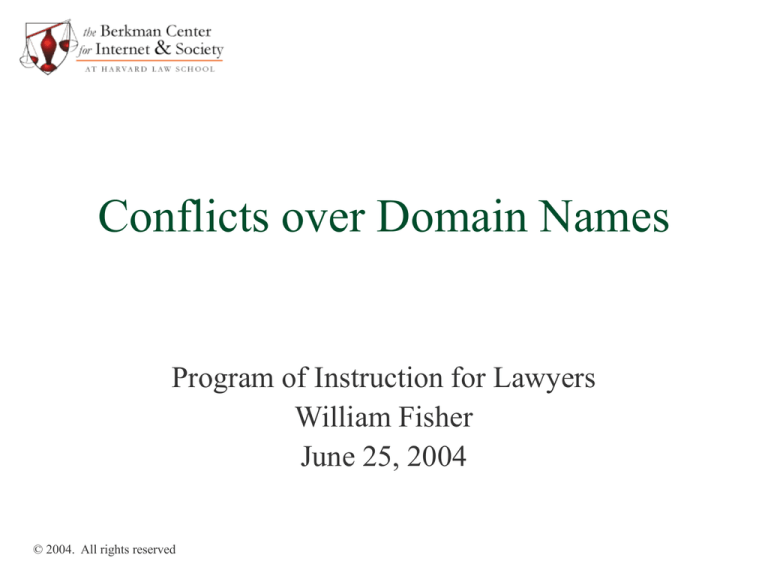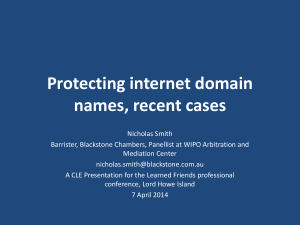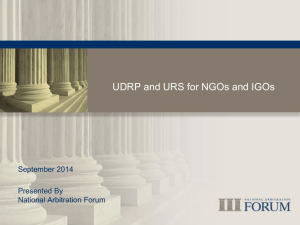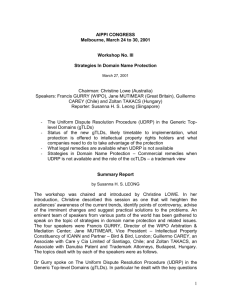
Conflicts over Domain Names
Program of Instruction for Lawyers
William Fisher
June 25, 2004
© 2004. All rights reserved
Types of
Domain-Name Disputes
Cybersquatting
Joshua Quittner registers
“mcdonalds.com”
Typosquatting
Misrosoft.com
Conflicts between Competitors
Kaplan.com
Conflicts between Noncompetitors
Howard Johnson registers
“howardjohnson.com”
Retailers
weber.com
Retailers
weber.com
webergrills.com
Commerical v. Noncommerical Users
(Reverse Domain Name Hijacking)
pokey.org
Prima Toy Company
(December 2, 2000)
Fan Sites
Parody and Commentary
http://www.introducingmonday.com
http://www.introducingmonday.co.uk/
http://www.introducingmonday.com
http://www.introducingmonday.co.uk/
Initial Legal Responses
Types of Trademark Infringement
Types of Trademark Infringement
Identical Marks on
Competitive Products
Types of Trademark Infringement
Identical Marks on
Competitive Products
Similar Marks on
Competitive Products
Axes and Factors in Assessing
Likelihood of Confusion
Similarity of Appearance
SQUIRT / QUIRST (for soft drinks)
Similarity of Sound
Huggies / Dougies (for disposable diapers)
Similarity of Meaning
Apple / Pineapple (for computer products)
Good Morning / Buenos Dias (for bath
products)
Marketing Environment
Types of Trademark Infringement
Identical Marks on
Competitive Products
Similar Marks on
Competitive Products
Types of Trademark Infringement
Identical Marks on
Competitive Products
Similar Marks on
Competitive Products
Similar Marks on
Noncompetitive
Products
Polaroid/McGregor Factors for
Noncompetitive Products
Ultimate issue: likelihood of confusion
Strength of the plaintiff’s mark
Similarity of the two marks
Proximity of the two products
Quality of the defendant’s product
Likelihood of the plaintiff “bridging the gap”
Actual confusion
Defendant’s “good faith”
Sophistication of buyers of the products
General equities
Varieties of “Consumer Confusion”
Source
Endorsement (e.g., Rolls Royce Radio Tubes)
Post-sale (e.g., Ferrari)
Initial Interest (e.g., Brookfield)
Types of Trademark Infringement
Identical Marks on
Competitive Products
Similar Marks on
Competitive Products
Similar Marks on
Noncompetitive
Products
Types of Trademark Infringement
Identical Marks on
Competitive Products
Similar Marks on
Competitive Products
Similar Marks on
Noncompetitive
Products
Dilution
Forms of Dilution (Clinique 1996)
“Dilution by blurring occurs where ‘the defendant uses or
modifies the plaintiff's trademark to identify the
defendant's goods and services, raising the possibility that
the mark will lose its ability to serve as a unique identifier
of the plaintiff's product.’ Like tarnishment, blurring is
concerned with an injury to the mark's selling power and
‘need not involve any confusion as to source or
sponsorship.’”
“Tarnishment may occur when the plaintiff's mark is used
by the defendant in association with unwholesome or
shoddy goods or services. Tarnishment may also result
from an association with obscenity, or sexual or illegal
activity, but is not limited to seamy conduct.”
International Development of
Dilution Doctrine
Originates in Germany, (Odol 1925)
Gradually expands in United States
Schecter, 1927
State anti-dilution statutes, 1947-present
Federal Trademark Dilution Act, 1996
Slow introduction elsewhere
Benelux countries, Germany adopt expansive doctrines
EC Harmonization Directive (1988) and EC
Community TM Regulation (1993) are ambiguous
• Benelux countries and France favor generous reading
• England and ECJ resist
Types of Trademark Infringement
Identical Marks on
Competitive Products
Similar Marks on
Competitive Products
Similar Marks on
Noncompetitive
Products
Dilution
Applications of TM Infringement
Doctrine to Domain Names
Amadeus Marketing (Italy 1997): TM owner must
prove operation of similar DN is directly
confusing or damaging to TM
British Telecommunications (UK 1998): A DN
incorporating a TM “shows an inherent tendency
to confuse” consumers
Champagne Céréales (France 1998): A DN
mimicking an unregistered TM creates excessive
likelihood of confusion
Braunschweig (Germany 1997): DN incorporating
name of a city creates likelihood of confusion
Problems
1) “Use in Commerce”?
2) Consumer Confusion?
3) Federal Dilution Doctrine only applies to
“famous” marks
4) Judicial proceedings are slow and
expensive
The New Legal Regime
Dispute-Resolution Systems
1) UDRP
2) Anticybersquatting Consumer
Protection Act
UDRP governs “Abusive
Registrations and Use” of DNs
the domain name is identical or
misleadingly similar to a trademark in
which someone else has rights.
the holder of the domain name has no rights
or legitimate interests in that domain name
the domain name has been registered and is
used in bad faith.
http://www.icann.org/dndr/udrp/uniform-rules.htm
UDRP governs “Abusive
Registrations and Use” of DNs
the domain name is identical or
misleadingly similar to a trademark in
which someone else has rights.
the holder of the domain name has no rights
or legitimate interests in that domain name
the domain name has been registered and is
used in bad faith.
http://www.icann.org/dndr/udrp/uniform-rules.htm
Examples of “Bad Faith”
Circumstances indicate that defendant’s main
purpose was to sell DN to TM owner for more
than the direct costs of registration
History of registering DNs to prevent TM owners
from registering
Registering a DN in order to disrupt the business
of a competitor
attempting to divert Internet users to Defendant’s
site for commercial gain by creating confusion
concerning source or sponsorship
Examples of “Legitimate Interests”
Pre-dispute use or demonstrable preparations
to use the DN in bona fide offering of goods
or services
Defendant was commonly known by the name
Legitimate, noncommercial or fair use of the
DN without intent to misleadingly divert or
tarnish
Coverage
All gTLDs
Aprx. 1/3 of ccTLDs
Procedure
Complainant picks forum
Respondents have 20 days to respond
No additional submissions typically are permitted
Decision within 14 days of appointment of panelist(s)
Respondents default 50% of the time
Remedies:
Cancellation of the registration
Transfer of the DN to the complainant
Losing respondent can postpone remedy by filing suit
within 20 days
UDRP Usage
As of May, 2004, 9377 proceedings
Roughly 15,000 domain names
(out of a total of aprx. 60,000,000 DNs of all sorts)
Rates of filing are declining gradually
Most of the DNs challenged under UDRP were
registered during the boom of early 2000
WIPO is the most popular provider, and becoming
more so – aprx. 70% of the cases
Plaintiffs win 71% of the time
See Convergence Center Database: http://dcc.syr.edu/markle/mhome.htm;
Mueller Report (6/24/2002): http://dcc.syr.edu/markle/markle-report-final.pdf
Mueller Report (6/24/2002): http://dcc.syr.edu/markle/markle-report-final.pdf
The End of the “Land Rush”?
From: http://dcc.syr.edu/markle/markle-report-final.pdf
The End of the “Land Rush”?
From: http://dcc.syr.edu/markle/markle-report-final.pdf
But registration of country-code TLDs continue to rise
Mueller Report (6/24/2002): http://dcc.syr.edu/markle/markle-report-final.pdf
UDRP Usage
As of May, 2004, 9377 proceedings
Roughly 15,000 domain names
(out of a total of aprx. 60,000,000 DNs of all sorts)
Rates of filing are declining gradually
Most of the DNs challenged under UDRP were
registered during the boom of early 2000
WIPO is the most popular provider, and becoming
more so – aprx. 70% of the cases
Plaintiffs win 71% of the time
See Convergence Center Database: http://dcc.syr.edu/markle/mhome.htm;
Mueller Report (6/24/2002): http://dcc.syr.edu/markle/markle-report-final.pdf
Examples of “Bad Faith”
Circumstances indicate that defendant’s main
purpose was to sell DN to TM owner for more
than the direct costs of registration
History of registering DNs to prevent TM owners
from registering
Registering a DN in order to disrupt the business
of a competitor
attempting to divert Internet users to Defendant’s
site for commercial gain by creating confusion
concerning source or sponsorship
Source: http://udrp.law.cornell.edu/udrp/stats.php
Examples of “Bad Faith”
Circumstances indicate that defendant’s main
30% purpose was to sell DN to TM owner for more
than the direct costs of registration
History of registering DNs to prevent TM owners
14% from registering
Registering a DN in order to disrupt the business
9% of a competitor
attempting to divert Internet users to Defendant’s
39% site for commercial gain by creating confusion
concerning source or sponsorship
15% Other forms of bad faith
14% No bad faith
Dispute-Resolution Systems
1) UDRP
2) Anticybersquatting Consumer
Protection Act
Dispute-Resolution Systems
1) UDRP
2) Anticybersquatting Consumer
Protection Act (UDRP on Steroids)
ACPA, 15 U.S.C. sec. 1125 (d)
TM owners have civil cause of action
against defendants who, with bad faith
intent to profit from the goodwill of a TM,
register or use a DN that is:
identical or confusingly similar to a distinctive
mark,
or dilutive of a famous mark
ACPA, 15 U.S.C. sec. 1125 (d)
TM owners have civil cause of action
against defendants who, with bad faith
intent to profit from the goodwill of a TM,
register or use a DN that is:
identical or confusingly similar to a distinctive
mark,
or dilutive of a famous mark
ACPA Factors
1. Does have IP rights in the DN?
2. Is the DN ’s legal or customary name?
3. ’s prior use of DN to offer goods/services
4. ’s prior noncommercial or fair use of DN
5. ‘s intent to divert business from and harm
good will by causing likelihood of confusion
6. ‘s offer to sell DN – or habit of doing so
7. Did provide false contact information
8. Did acquire multiple DNs similar to TMs
9. How distinctive or famous is ’s mark?
Safe Harbor:
“Bad faith intent” shall not be found where
the defendant “believed and had reasonable
grounds to believe that the use of the
domain name was a fair use or otherwise
lawful”
Remedies
Injunctive Relief (retroactive)
Damages (nonretroactive)
Statutory Damages (nonretroactive)
$1000 - $100,000 per domain name
In rem jurisdiction
Registrars may sua sponte refuse to register
marks that they deem to violate the rules
Application of ACPA
People for Ethical Treatment of Animals v.
Doughney (EDVa 2000): peta.org used for
parody site: “People eating tasty animals”
Links to leather-goods and meat websites
ACPA Factors
1. Does have IP rights in the DN?
2. Is the DN ’s legal or customary name?
3. ’s prior use of DN to offer goods/services
4. ’s prior noncommercial or fair use of DN
5. ‘s intent to divert business from and harm
good will by causing likelihood of confusion
6. ‘s offer to sell DN – or habit of doing so
7. Did provide false contact information
8. Did acquire multiple DNs similar to TMs
9. How distinctive or famous is ’s mark?
PETA
1. Does have IP rights in the DN?
2. Is the DN ’s legal or customary name?
3. ’s prior use of DN to offer goods/services
4. ’s prior noncommercial or fair use of DN
5. ‘s intent to divert business from and harm
good will by causing likelihood of confusion
6. ‘s offer to sell DN – or habit of doing so
7. Did provide false contact information
8. Did acquire multiple DNs similar to TMs
9. How distinctive or famous is ’s mark?
PETA
1. Does have IP rights in the DN?
2. Is the DN ’s legal or customary name?
3. ’s prior use of DN to offer goods/services
?
4. ’s prior noncommercial or fair use of DN
?
5. ‘s intent to divert business from and harm
good will by causing likelihood of confusion
6. ‘s offer to sell DN – or habit of doing so
?
7. Did provide false contact information
?
8. Did acquire multiple DNs similar to TMs
9. How distinctive or famous is ’s mark?
Applications of ACPA
People for Ethical Treatment of Animals v.
Doughney (EDVa 2000): peta.org used for
parody site: “People eating tasty animals”
Links to leather-goods and meat websites
Mattel v. Schiff (SDNY 2000):
barbiesplaypen.com for commercial porn
club
ACPA Factors
1. Does have IP rights in the DN?
2. Is the DN ’s legal or customary name?
3. ’s prior use of DN to offer goods/services
4. ’s prior noncommercial or fair use of DN
5. ‘s intent to divert business from and harm
good will by causing likelihood of confusion
6. ‘s offer to sell DN – or habit of doing so
7. Did provide false contact information
8. Did acquire multiple DNs similar to TMs
9. How distinctive or famous is ’s mark?
Mattel
1. Does have IP rights in the DN?
2. Is the DN ’s legal or customary name?
3. ’s prior use of DN to offer goods/services
4. ’s prior noncommercial or fair use of DN
5. ‘s intent to divert business from and harm
good will by causing likelihood of confusion
6. ‘s offer to sell DN – or habit of doing so
7. Did provide false contact information
8. Did acquire multiple DNs similar to TMs
9. How distinctive or famous is ’s mark?
Doctrines
Doctrines
UDRP
ACPA
Trademark
Infringement -Likelihood of
Confusion
Trademark
Dilution
Unfair
Competition
Doctrines
UDRP
ACPA
Trademark
Infringement -Likelihood of
Confusion
Trademark
Dilution
Unfair
Competition
Types of Conflict
Cybersquatting
Typosquatting
Competing Use
Noncompeting Use
Reverse Domain Name
Hijacking
Retailers
Fan Sites
Parody and Commentary
Doctrines
UDRP
ACPA
Trademark
Infringement -Likelihood of
Confusion
Trademark
Dilution
Unfair
Competition
}
Types of Conflict
Cybersquatting
Typosquatting
Competing Use
Noncompeting Use
Reverse Domain Name
Hijacking
Retailers
Fan Sites
Parody and Commentary
{
Doctrines
UDRP
ACPA
Trademark
Infringement -Likelihood of
Confusion
Trademark
Dilution
Unfair
Competition
}
Types of Conflict
Cybersquatting
Typosquatting
Competing Use
Noncompeting Use
Reverse Domain Name
Hijacking
Retailers
Fan Sites
Parody and Commentary
{
Doctrines
UDRP
ACPA
Trademark
Infringement -Likelihood of
Confusion
Trademark
Dilution
Unfair
Competition
}
Types of Conflict
Cybersquatting
Typosquatting
Competing Use
Noncompeting Use
Reverse Domain Name
Hijacking
Retailers
Fan Sites
Parody and Commentary
{
Defects of UDRP
Complainant picks forum
No appellate process
Simplified procedures ill suited to
complex cases
Arbitrators reach cases not intended
by the policy
General Problems
Unnecessarily complex
Unpredictable outcomes
Trademark owners have too much power;
domain-name owners too little
Excessive Impediments to Freedom of
Speech
Alternatives to the Current
Legal Regime
Alternatives
1) Improved UDRP
2) More GTLDs
3) Eliminate protection for generic domain
names
4) Increased latitude for criticism and parody
5) Return to first-come, first-served
6) Repudiate domain names altogether
7) Domain names naturally atrophy
Alternatives
1) Improved UDRP
2) More GTLDs
3) Eliminate protection for generic domain
names
4) Increased latitude for criticism and parody
5) Return to first-come, first-served
6) Repudiate domain names altogether
7) Domain names naturally atrophy
Improved UDRP
Defects:
Complainant picks
forum
No appellate process
Simplified
procedures ill suited
to complex cases
Arbitrators reach
cases not intended
by the policy
Innocent defaults
Improved UDRP
Defects:
Complainant picks
forum
No appellate process
Simplified
procedures ill suited
to complex cases
Arbitrators reach
cases not intended
by the policy
Innocent defaults
Possible Remedies
Improved UDRP
Defects:
Complainant picks
forum
No appellate process
Simplified
procedures ill suited
to complex cases
Arbitrators reach
cases not intended
by the policy
Innocent defaults
Possible Remedies
Disputes assigned
randomly to licensed
providers, or
Improved UDRP
Defects:
Complainant picks
forum
No appellate process
Simplified
procedures ill suited
to complex cases
Arbitrators reach
cases not intended
by the policy
Innocent defaults
Possible Remedies
Disputes assigned
randomly to licensed
providers, or
Registrars pick
providers (Mueller)
Improved UDRP
Defects:
Complainant picks
forum
No appellate process
Simplified
procedures ill suited
to complex cases
Arbitrators reach
cases not intended
by the policy
Innocent defaults
Possible Remedies
Disputes assigned
randomly to licensed
providers, or
Registrars pick
providers (Mueller)
Establish internal
appellate process (loser
pays)
Improved UDRP
Defects:
Complainant picks
forum
No appellate process
Simplified
procedures ill suited
to complex cases
Arbitrators reach
cases not intended
by the policy
Innocent defaults
Possible Remedies
Disputes assigned
randomly to licensed
providers, or
Registrars pick
providers (Mueller)
Establish internal
appellate process (loser
pays)
Add discovery system,
or
Improved UDRP
Defects:
Complainant picks
forum
No appellate process
Simplified
procedures ill suited
to complex cases
Arbitrators reach
cases not intended
by the policy
Innocent defaults
Possible Remedies
Disputes assigned
randomly to licensed
providers, or
Registrars pick
providers (Mueller)
Establish internal
appellate process (loser
pays)
Add discovery system,
or
Reduce jurisdiction
Improved UDRP
Defects:
Complainant picks
forum
No appellate process
Simplified
procedures ill suited
to complex cases
Arbitrators reach
cases not intended
by the policy
Innocent defaults
Possible Remedies
Disputes assigned
randomly to licensed
providers, or
Registrars pick
providers (Mueller)
Establish internal
appellate process (loser
pays)
Add discovery system,
or
Reduce jurisdiction
Improved UDRP
Defects:
Complainant picks
forum
No appellate process
Simplified
procedures ill suited
to complex cases
Arbitrators reach
cases not intended
by the policy
Innocent defaults
Possible Remedies
Disputes assigned
randomly to licensed
providers, or
Registrars pick
providers (Mueller)
Establish internal
appellate process (loser
pays)
Add discovery system,
or
Reduce jurisdiction
$1000 bond (Mueller)
Alternatives
1) Improved UDRP
2) More GTLDs
3) Eliminate protection for generic domain
names
4) Increased latitude for criticism and parody
5) Return to first-come, first-served
6) Repudiate domain names altogether
7) Domain names naturally atrophy
Alternatives
1) Improved UDRP
2) More GTLDs
3) Eliminate protection for generic domain
names
4) Increased latitude for criticism and parody
5) Return to first-come, first-served
6) Repudiate domain names altogether
7) Domain names naturally atrophy
Major gTLDs
.com and .net: 30,400,000
More gTLDs
.aero
.biz
.coop
.info
.museum
.name
.pro
Aviation
Businesses
Cooperatives
Unrestricted
Museums
Personal names
Professionals
Operator
SITA
NeuLevel
dotCoop
Afilias
MuseDoma
Global Name Registry
RegistryPro
Reducing Scarcity?
See Zittrain & Edelman at
http://cyber.law.harvard.edu/tlds/001/
Alternatives
1) Improved UDRP
2) More GTLDs
3) Eliminate protection for generic domain
names
4) Increased latitude for criticism and parody
5) Return to first-come, first-served
6) Repudiate domain names altogether
7) Domain names naturally atrophy
Alternatives
1) Improved UDRP
2) More GTLDs
3) Eliminate protection for generic domain
names
4) Increased latitude for criticism and parody
5) Return to first-come, first-served
6) Repudiate domain names altogether
7) Domain names naturally atrophy
Trademark Doctrine: No
protection for generic marks
Inherently generic marks
E.g., Alaska Salmon; Convenience Store
Marks that become generic through use
E.g., thermos, kleenex; lite beer
Basis of the rule: excessive threat to
competition
Domain-Name practice currently
deviates from this rule
Domain-Name practice currently
deviates from this rule
Trademark owners are sometimes
able to control generic domain names
E.g., crew.com
Domain-Name practice currently
deviates from this rule
Trademark owners are sometimes
able to control generic domain names
E.g., crew.com
Generic domain names are protected
(by law) against “confusingly
similar” domain names
E.g., E-cards.com vs. Ecards.com
Domain-Name practice currently
deviates from this rule
Trademark owners are sometimes
able to control generic domain names
E.g., crew.com
Generic domain names are protected
(by law) against “confusingly
similar” domain names
E.g., E-cards.com vs. Ecards.com
Generic domain names are protected
(by code) against identical domain
names
Only one firm can use sex.com
Domain-Name practice currently
deviates from this rule
Trademark owners are sometimes
able to control generic domain names
E.g., crew.com
Generic domain names are protected
(by law) against “confusingly
similar” domain names
E.g., E-cards.com vs. Ecards.com
Generic domain names are protected
(by code) against identical domain
names
Only one firm can use sex.com
Reverse
this rule
Domain-Name practice currently
deviates from this rule
Trademark owners are sometimes
able to control generic domain names
E.g., crew.com
Generic domain names are protected
(by law) against “confusingly
similar” domain names
E.g., E-cards.com vs. Ecards.com
Generic domain names are protected
(by code) against identical domain
names
Only one firm can use sex.com
Reverse
this rule
Reverse
this rule
Domain-Name practice currently
deviates from this rule
Trademark owners are sometimes
able to control generic domain names
E.g., crew.com
Generic domain names are protected
(by law) against “confusingly
similar” domain names
E.g., E-cards.com vs. Ecards.com
Generic domain names are protected
(by code) against identical domain
names
Only one firm can use sex.com
Reverse
this rule
Reverse
this rule
Either:
(a) Refuse
registration, or
(b) Mandatory
index page
(cf. Mattel v. Hasbro)
Alternatives
1) Improved UDRP
2) More GTLDs
3) Eliminate protection for generic domain
names
4) Increased latitude for criticism and parody
5) Return to first-come, first-served
6) Repudiate domain names altogether
7) Domain names naturally atrophy
Alternatives
1) Improved UDRP
2) More GTLDs
3) Eliminate protection for generic domain
names
4) Increased latitude for criticism and parody
5) Return to first-come, first-served
6) Repudiate domain names altogether
7) Domain names naturally atrophy
Increased Latitude for Criticism
and Parody
Permit registration of all DNs whose critical
purpose is apparent on their face
E.g., verizonsucks.com; yahooka.com
Doctrinal basis: not “confusingly similar”
Recognize criticism as a legitimate use
under UDRP, ACPA, and dilution doctrine
E.g., PETA case and Jews for Jesus case would
be decided differently
Alternatives
1) Improved UDRP
2) More GTLDs
3) Eliminate protection for generic domain
names
4) Increased latitude for criticism and parody
5) Return to first-come, first-served
6) Repudiate domain names altogether
7) Domain names naturally atrophy
Alternatives
1) Improved UDRP
2) More GTLDs
3) Eliminate protection for generic domain
names
4) Increased latitude for criticism and parody
5) Return to first-come, first-served
6) Repudiate domain names altogether
7) Domain names naturally atrophy
Return to first-come, first-served
Analogy to buying up rights to newly
discovered valuable resource
E.g., Edison and bamboo
Rely on the market to get DNs into the
hands of firms best able to use them
Limit relief to the conduct of a website in a
fashion likely to cause consumer confusion
Cf. Amadeus
Alternatives
1) Improved UDRP
2) More GTLDs
3) Eliminate protection for generic domain
names
4) Increased latitude for criticism and parody
5) Return to first-come, first-served
6) Repudiate domain names altogether
7) Domain names naturally atrophy
Alternatives
1) Improved UDRP
2) More GTLDs
3) Eliminate protection for generic domain
names
4) Increased latitude for criticism and parody
5) Return to first-come, first-served
6) Repudiate domain names altogether
7) Domain names naturally atrophy
Repudiate Domain Names
DNs are not essential to navigation of the
Internet
Dispense with the system in favor of IP
Addresses
Consumers will rely on search engines,
links, and bookmarks
Alternatives
1) Improved UDRP
2) More GTLDs
3) Eliminate protection for generic domain
names
4) Increased latitude for criticism and parody
5) Return to first-come, first-served
6) Repudiate domain names altogether
7) Domain names naturally atrophy
Alternatives
1) Improved UDRP
2) More GTLDs
3) Eliminate protection for generic domain
names
4) Increased latitude for criticism and parody
5) Return to first-come, first-served
6) Repudiate domain names altogether
7) Domain names naturally atrophy
Domain Names Atrophy
Value of domain names may diminish
naturally as search engines become more
powerful and ubiquitous
Alternatives
1) Improved UDRP
2) More GTLDs
3) Eliminate protection for generic domain
names
4) Increased latitude for criticism and parody
5) Return to first-come, first-served
6) Repudiate domain names altogether
7) Domain names naturally atrophy
Who Won?
Who Should be Awarded These DNs?
Registrant
Complainant
Webergrill.com
BBQ Pit
Weber
Crew.com
Nat Cohen
J.Crew
Peta.com
People Eating
Tasty Animals
People for the
Ethical Treatment of
Animals
Kumbhmela.com
Jaga
Government of India
Southafrica.com
Virtual
Government of
Countries, Inc. South Africa
BruceSpringsteen.com
Jeff Burgar
Bruce Springsteen
Verizonreallysucks.com
2600
Magazine
Verizon
IntroducingMonday.co.uk
B3TA
Price Waterhouse
Cooper Consulting
3rd party
Actual Winners
Registrant
Complainant
Webergrill.com
BBQ Pit
Weber
Crew.com
Nat Cohen
J.Crew
Peta.com
People Eating
Tasty Animals
People for the
Ethical Treatment
of Animals
Kumbhmela.com
Jaga
Government of India
Southafrica.com
Virtual
Government of
Countries, Inc. South Africa
BruceSpringsteen.com
Jeff Burgar
Verizonreallysucks.com
2600 Magazin Verizon
IntroducingMonday.co.uk
B3TA
Bruce Springsteen
Price Waterhouse
Cooper Consulting
3rd party
Typical Winners in Cases of this Sort
Registrant
Complainant
Webergrill.com
BBQ Pit
Weber
Crew.com
Nat Cohen
J.Crew
Peta.com
People Eating
Tasty Animals
People for the
Ethical Treatment of
Animals
Kumbhmela.com
Jaga
Government of India
Southafrica.com
Virtual
Countries
Government of South
Africa
BruceSpringsteen.com
Jeff Burgar
Bruce Springsteen
Verizonreallysucks.com
2600
Magazine
Verizon
IntroducingMonday.co.uk
B3TA
Price Waterhouse
Cooper Consulting
3rd party






